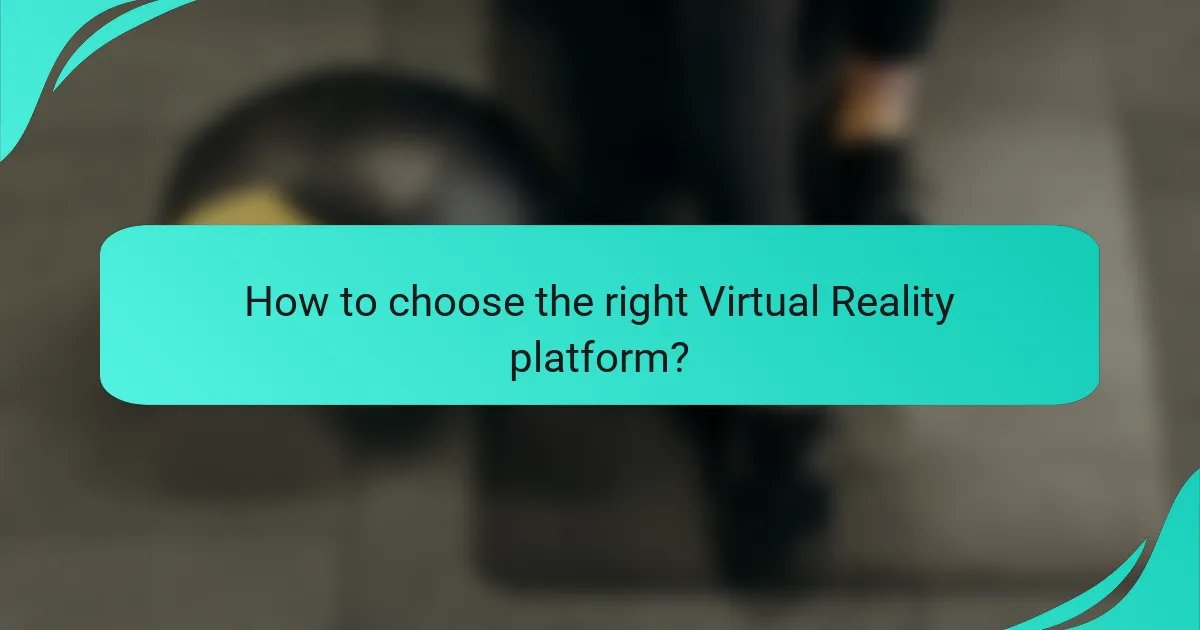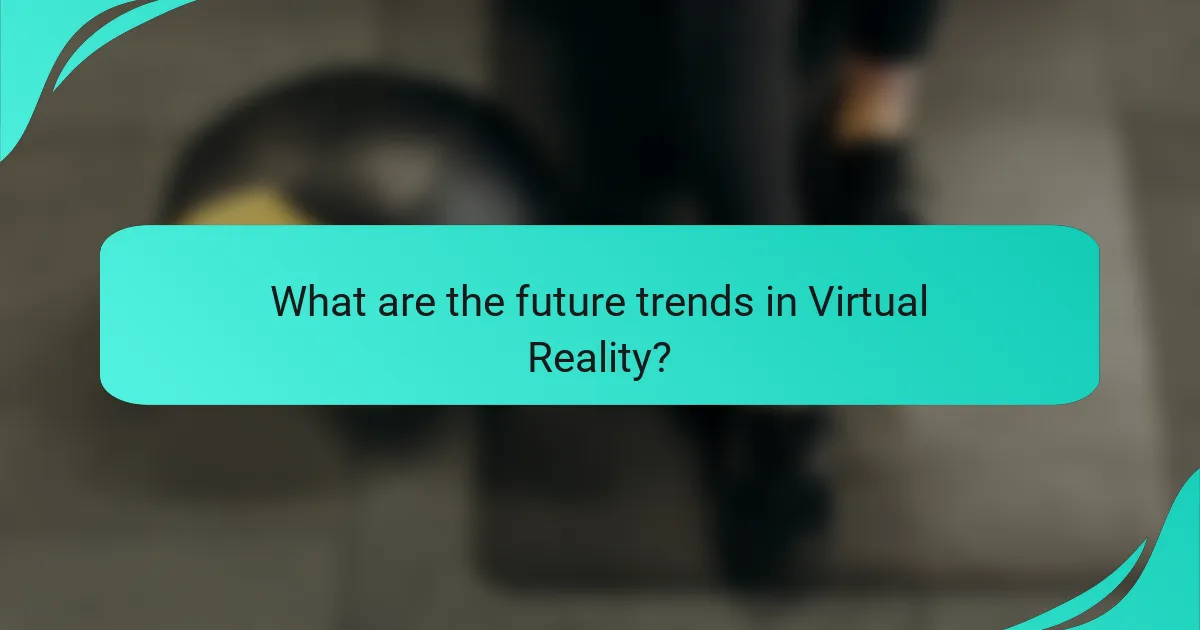Virtual Reality (VR) is revolutionizing user engagement by creating immersive environments that captivate attention and promote active participation. By leveraging sensory experiences, VR fosters deeper connections with content, making interactions more memorable. This technology not only enhances user experiences but also provides businesses with a competitive edge through innovative marketing strategies and increased brand loyalty.

How does Virtual Reality enhance user engagement?
Virtual Reality (VR) enhances user engagement by creating immersive environments that captivate users’ attention and encourage active participation. This technology leverages sensory experiences to foster deeper connections with content, making interactions more memorable and impactful.
Immersive experiences
Immersive experiences in VR transport users into realistic virtual worlds, stimulating sight, sound, and sometimes even touch. This level of immersion can lead to heightened emotional responses, making users feel as if they are part of the experience rather than mere observers.
For example, VR can simulate environments such as historical sites or natural landscapes, allowing users to explore these settings interactively. This can be particularly effective in education and training, where real-world scenarios can be recreated safely and effectively.
Interactive simulations
Interactive simulations in VR allow users to engage with content dynamically, making decisions that influence outcomes. This hands-on approach can enhance learning and retention by encouraging users to experiment and explore various scenarios.
For instance, medical students can practice surgical procedures in a risk-free virtual setting, gaining valuable experience without the consequences of real-life mistakes. Such simulations can significantly improve skill acquisition and confidence in practical applications.
Gamification elements
Incorporating gamification elements into VR experiences can further boost user engagement by adding competitive and rewarding aspects. Features like points, levels, and challenges motivate users to participate actively and strive for improvement.
For example, a VR training program might include leaderboards or achievement badges, encouraging users to complete tasks and improve their performance. This not only makes the experience more enjoyable but also fosters a sense of accomplishment and community among participants.

What are the competitive advantages of Virtual Reality?
Virtual Reality (VR) offers several competitive advantages, including enhanced user engagement, immersive experiences, and innovative marketing strategies. These benefits can lead to increased brand loyalty, deeper customer insights, and unique opportunities for businesses to differentiate themselves in the market.
Increased brand loyalty
VR can significantly boost brand loyalty by creating memorable and immersive experiences for customers. When users engage with a brand through VR, they often form a stronger emotional connection, which can lead to repeat business and advocacy.
For example, a retail brand that allows customers to virtually try on clothes or experience products in a simulated environment can foster a sense of trust and satisfaction, encouraging customers to return. Businesses should focus on creating high-quality VR experiences that resonate with their target audience to maximize this advantage.
Enhanced customer insights
Virtual Reality provides businesses with valuable insights into customer behavior and preferences. By analyzing how users interact within a VR environment, companies can gather data on engagement patterns, decision-making processes, and emotional responses.
This information can be used to tailor marketing strategies and improve product offerings. For instance, a company might discover that customers prefer certain features in a virtual product demonstration, allowing them to refine their actual products accordingly.
Unique marketing opportunities
VR opens up unique marketing opportunities that traditional media cannot match. Brands can create immersive storytelling experiences that captivate audiences and convey their messages more effectively.
For example, a travel company could offer virtual tours of destinations, allowing potential customers to experience a location before booking a trip. This innovative approach not only attracts attention but also enhances the likelihood of conversion. Businesses should explore creative VR campaigns that align with their brand identity and engage their audience in novel ways.

Which industries benefit most from Virtual Reality?
Virtual Reality (VR) significantly enhances various industries by providing immersive experiences that improve engagement and operational efficiency. Key sectors that benefit from VR include healthcare, real estate, and education, each leveraging the technology to transform traditional practices.
Healthcare applications
In healthcare, VR is used for surgical simulations, patient treatment, and medical training. For instance, surgeons can practice complex procedures in a risk-free virtual environment, enhancing their skills before operating on real patients.
Additionally, VR is effective in treating phobias and PTSD by exposing patients to controlled scenarios, allowing them to confront fears in a safe space. This approach can lead to significant improvements in patient outcomes.
Real estate virtual tours
Real estate professionals utilize VR to create virtual tours of properties, allowing potential buyers to explore homes remotely. This technology saves time and resources by enabling clients to view multiple properties without the need for physical visits.
Moreover, VR can enhance marketing efforts by providing immersive experiences that showcase properties in a more engaging manner. This can lead to quicker sales and a broader reach in the competitive real estate market.
Education and training
In education, VR offers interactive learning experiences that can enhance student engagement and retention. For example, students can explore historical sites or conduct science experiments in a virtual lab, making learning more dynamic and impactful.
Training programs in various industries, such as aviation and manufacturing, also benefit from VR. Employees can practice skills in a simulated environment, reducing training costs and improving safety by minimizing real-world risks during the learning process.

What are the key technologies powering Virtual Reality?
The key technologies driving Virtual Reality (VR) include head-mounted displays, motion tracking systems, and spatial audio technology. These components work together to create immersive experiences that engage users in virtual environments.
Head-mounted displays
Head-mounted displays (HMDs) are essential for delivering visual content directly to the user’s eyes, creating a sense of presence in a virtual space. They typically feature high-resolution screens and wide field-of-view lenses to enhance immersion.
When choosing an HMD, consider factors such as resolution, refresh rate, and comfort. Popular models range from budget-friendly options around $200 to high-end devices exceeding $1,000, catering to different user needs and experiences.
Motion tracking systems
Motion tracking systems capture the user’s movements and translate them into the virtual environment, allowing for interactive experiences. These systems can be optical, using cameras to track markers, or inertial, relying on sensors to detect motion.
For optimal performance, ensure the tracking system has low latency and high accuracy. Many systems support both room-scale tracking, which allows users to move freely, and seated experiences, which are suitable for smaller spaces.
Spatial audio technology
Spatial audio technology enhances the realism of VR by simulating how sound behaves in a three-dimensional space. This technology allows users to perceive sound direction and distance, making the virtual environment feel more lifelike.
When implementing spatial audio, consider using headphones that support surround sound or binaural audio. This can significantly improve immersion, especially in gaming or training simulations where audio cues are crucial for navigation and interaction.

How to choose the right Virtual Reality platform?
Choosing the right Virtual Reality (VR) platform involves assessing compatibility with your existing hardware, the availability of content that meets your needs, and the overall costs associated with the platform. Each of these factors plays a crucial role in ensuring a satisfying and immersive VR experience.
Platform compatibility
Platform compatibility refers to how well a VR system works with your current devices, such as computers or gaming consoles. Before selecting a platform, check the hardware requirements, including processing power, graphics capabilities, and available ports. For instance, some platforms may require high-end GPUs, while others can operate on mid-range systems.
Additionally, consider whether the platform supports cross-compatibility with other devices. This can enhance your experience by allowing you to use various peripherals or access a broader range of content. Always verify compatibility with your specific setup to avoid unexpected costs or limitations.
Content availability
Content availability is a critical factor in selecting a VR platform, as it determines the range of experiences you can access. Look for platforms that offer a diverse library of games, educational programs, and simulations that align with your interests. Popular platforms like Oculus and PlayStation VR often have exclusive titles that may influence your decision.
It’s also beneficial to check for regular updates and new releases, as a platform with a growing library can provide ongoing value. Consider user reviews and ratings to gauge the quality of the available content, ensuring it meets your expectations for immersion and engagement.
Cost considerations
Cost considerations encompass not only the initial price of the VR headset but also ongoing expenses such as software purchases, subscriptions, and potential upgrades. Headsets can range from budget-friendly options around a few hundred USD to high-end models exceeding a thousand USD. Evaluate your budget and determine what features are essential for your needs.
Additionally, factor in the costs of compatible hardware if your current setup is insufficient. Some platforms may require specific accessories or upgrades, which can add to the overall investment. Always compare the total cost of ownership to make an informed decision that aligns with your financial situation.

What are the future trends in Virtual Reality?
The future trends in Virtual Reality (VR) are shaping the way users interact with digital environments, focusing on enhanced immersion, broader applications, and improved accessibility. Key developments include advancements in hardware, software integration, and the rise of social VR experiences.
Increased Immersion through Advanced Hardware
Future VR systems are expected to feature more sophisticated hardware, such as higher resolution displays, improved field of view, and enhanced motion tracking. These advancements will create a more realistic and immersive experience, allowing users to feel as though they are truly part of the virtual environment.
For instance, headsets with eye-tracking technology can adjust the focus based on where the user is looking, which enhances realism. Additionally, haptic feedback devices will provide tactile sensations, further bridging the gap between the virtual and physical worlds.
Broader Applications Across Industries
Virtual Reality is expanding beyond gaming into various sectors, including education, healthcare, and real estate. In education, VR can simulate complex scenarios for training purposes, allowing students to practice skills in a safe environment.
In healthcare, VR is being used for surgical training and patient therapy, while real estate agents utilize VR for virtual property tours. This trend indicates a growing recognition of VR’s potential to enhance learning and operational efficiency across multiple fields.
Enhanced Social Interactions in Virtual Spaces
The future of VR will likely see a surge in social interactions within virtual environments. Platforms that facilitate social VR experiences are emerging, allowing users to meet, collaborate, and socialize in immersive settings.
These platforms can host events, meetings, and social gatherings, making them appealing for both personal and professional use. As technology evolves, the ability to connect with others in a virtual space will become more seamless and engaging.
Improved Accessibility and Affordability
As VR technology matures, accessibility and affordability are expected to improve significantly. Lower-cost headsets and more user-friendly software will make VR experiences available to a wider audience.
Efforts to create cross-platform compatibility will also enhance accessibility, allowing users to engage with VR content regardless of their device. This democratization of technology will drive broader adoption and innovation in the VR space.
